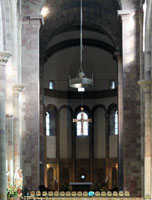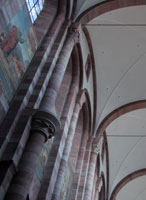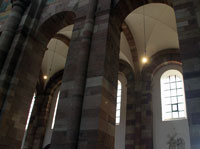

| The original cathedral begun by Conrad II would have been designed to have a huge transverse barrel vault (a span of almost 45 feet) but this proved to be impossible. So it was likely spanned then with a wooden vaualt. In the second phase of the building, with the original dimensions maintained, the stone vaulting and supporting structures were added. |  |
 |
New vaulting during reign of Henry IV"Strong lesenes were attached to the wall projection on every other pier to carry the barrel arches of the vaults. Broad semicircular columns with Corinthian capitals were in turn placed on the lesenes and from these spsrang the transverse arches dividing the individual vaulted sections. The nave is thus divided into six bays, each nave baya corresponding to two aisle bays" (Toman 48). This orderly division into bays contrasts with earlier Ottonian architecture and mirrors developments in southern Romanesque churches. In addition, the alternation of supports creates a rhythm that was copied elsewhere. | ||
 |
 |
Solid, strongly modelled walls(See plan for cathedral.) |
Nave arcade with clerestory windows in alighnmentWindows in the aisles are also on the same axis. |
 |
 |
On the frescoes:This website says:"In 1843 when Speyer and Palatinate were part of the Kingdom Bavaria King Ludwig I commissioned the painting of almost the entire the cathedral’s interior with frescoes. The painter Johann Baptist Schraudolph was in charge to compile this task; it took him and his co-workers 7 1/2 years to finish the frescoes. The themes were closely related to the cathedral: life of Saint Stephen and Mother Mary, and also a cycle about Bernard de Clairvaux’s visit to town and cathedral during Christmas 1146. The paintings were all in Nazarene movement style, a style which was quite prominent during the first part of 19th century. However, the idea of the cathedral’s intense restoration mid 20th century was to recreate the Romanesque interior as close as possible. Consequently this meant that the frescoes were removed. However, one of the restorers, Otto Schulz, applied a technique to remove many of the frescoes without destroying them. At the end, only the 24 frescoes of Mother Mary cycle including scenes of Old and New Testament on both sides of the central nave were left, which we can still see today." | ||
Return to page 1.
 Click here to return to index of art historical sites.
Click here to return to index of art historical sites.
 Click here to return to index of artists and architects.
Click here to return to index of artists and architects.
 Click here to return to chronological index.
Click here to return to chronological index.
 Click here to see the home page of Bluffton University.
Click here to see the home page of Bluffton University.
